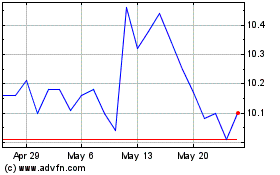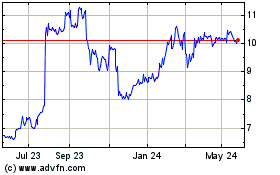U. K. 10-Year Gilt Yields Falls Below 1%
June 27 2016 - 6:40AM
Dow Jones News
Investors piling into safe-haven assets pushed the yield on
10-year U.K. government debt below 1% for the first time ever on
Monday.
The 10-year gilt yield fell around 0.17 of a percentage point to
0.94% during European morning trade, according to Tradeweb.
The yield on this debt has now dropped over 0.4 of a percentage
point since Britain voted to leave the European Union on Thursday,
a vote that sparked a rapid rise in the value of ultrasafe
government bonds around the world.
"It is a flight to quality effect," said Olivier De Larouziè re,
head of interest rates at Natixis Asset Management.
Investors are selling equities and riskier corporate bonds and
heading for the safety of sovereign debt, he added.
Investors continued to sell down the British pound and U.K.
stocks, particularly financial shares, Monday after steep falls at
the end of last week. The FTSE 250 was down 3.5% recently, while
the pound fell to its lowest level against the dollar since 1985
during morning trading.
Shares in Barclays PLC and Lloyds Banking Group PLC were down
10% and 8.3% respectively.
Money poured into other haven government debt. The yield on
10-year German debt was around 0.04 percentage point lower at minus
0.1%, while the yield on the 10-year Treasury note fell to 1.47%
from Friday's close of 1.58%.
In the run-up to the referendum, investors had been split on
which direction gilts would trade if Britain voted to leave the
EU.
Some argued international investors would shun all U.K. assets
and sell gilts, while others predicted British government debt
would keep its haven status and rally as funds continued to dial
back risk.
So far, the haven argument has won. Investors looking for a safe
place to park their money have pushed yields lower.
"You are not seeing any indication of a buyer flight pushing up
yields," said Jacob Nell, an economist at Morgan Stanley. "As the
pound weakens, U.K. assets become more attractive."
But uncertainty about what the Bank of England will do with
interest rates is also making investors wary.
The Bank of England will be torn between lowering interest rates
to provide relief to the economy from any adverse consequences of
exiting the EU, and raising them to defend the pound.
Gilts would benefit further from lower interest rates, while
tighter monetary policy would likely hit the market.
Gov. Mark Carney on Friday moved swiftly to reassure markets
that the central bank stood ready to backstop the financial system
should nervousness about the vote spread. He said the BOE has lined
up at least £ 250 billion ($342 billion) of financing for banks
that need it and has arrangements in place with other central banks
that allow it to provide cash in a variety of currencies.
Mr. Carney will detail the BOE's latest thinking on the
stability of the financial system when he presents the central
bank's biannual financial stability report July 5. The interest
rate-setting Monetary Policy Committee's next scheduled
announcement on interest rates is on July 14.
As most British financial markets plummeted, U.K. Treasury Chief
George Osborne moved to reassure households, businesses and
financial markets that the U.K. economy remains resilient.
"I'm going to work very hard to make sure we mitigate the impact
and remind people of the fundamental strengths of the British
economy," he told reporters.
In the run up to last week's vote, Mr. Osborne had repeatedly
warned there will be an "inevitable adjustment" as uncertainty the
U.K.'s future prospects dents spending and investment. That could
weaken growth and hit public finances, Mr. Osborne said.
"As I said before the referendum, this will have an impact on
the economy and the public finances, and there will need to be
action to address that," Mr. Osborne said on Monday.
Jon Sindreu contributed to this article.
Write to Christopher Whittall at christopher.whittall@wsj.com
and Jason Douglas at jason.douglas@wsj.com
(END) Dow Jones Newswires
June 27, 2016 07:25 ET (11:25 GMT)
Copyright (c) 2016 Dow Jones & Company, Inc.
Pacific Current (ASX:PAC)
Historical Stock Chart
From Oct 2024 to Nov 2024

Pacific Current (ASX:PAC)
Historical Stock Chart
From Nov 2023 to Nov 2024
